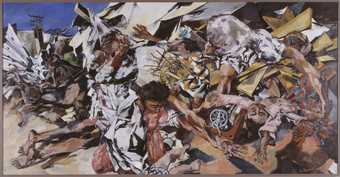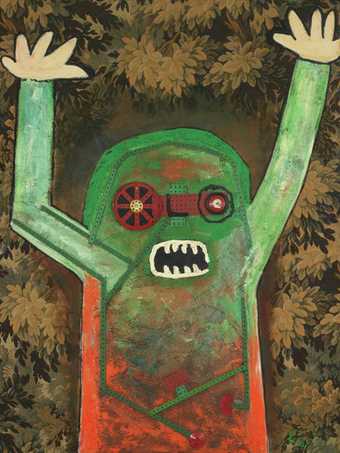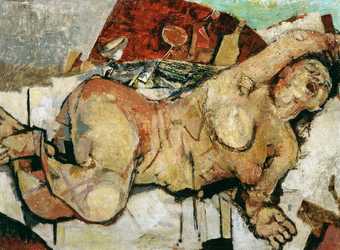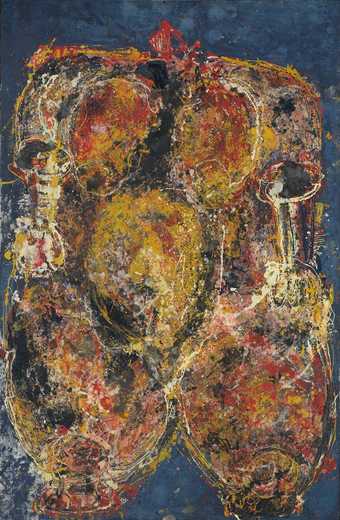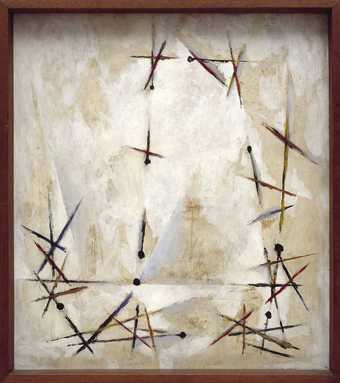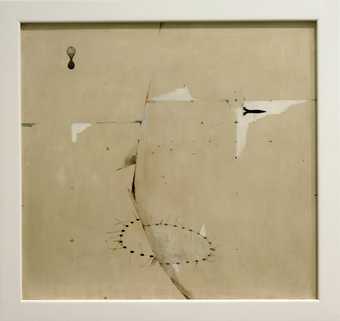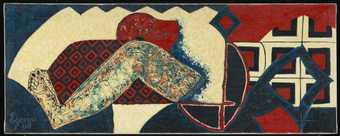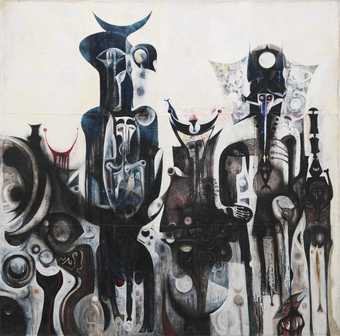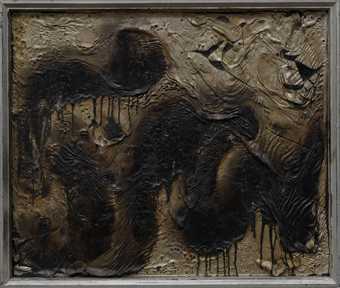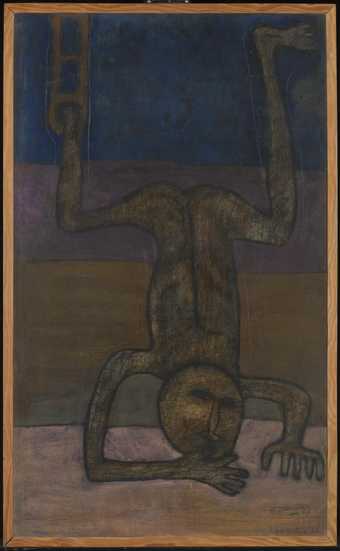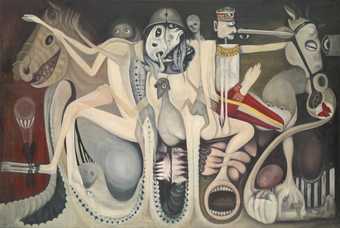
Not on display
- Artist
- Farid Belkahia 1934–2014
- Medium
- Oil paint on paper on plywood
- Dimensions
- Object: 626 × 446 mm
frame: 796 × 618 × 72 mm - Collection
- Tate
- Acquisition
- Purchased with funds provided by the Middle East North Africa Acquisitions Committee 2016
- Reference
- T14627
Summary
Cuba Si 1961 is painted in oil on paper which has been mounted onto board. The composition shows the head and shoulders of a primitively rendered figure, whose elongated arms are raised and encircle his head, one clenched fist grasping the other. On his chest he wears some form of badge or rosette. The facial features are simplified, with the wide round eyes and dark circle of the open mouth suggesting an expression of surprise or emphatic assertion. This last seems most likely given the work’s title, Cuba Si, which translates as ‘Yes Cuba!’.
To make the work, Belkahia employed a technique in which the figure was almost carved or dug out of the paint, this gesture being close to that of a sculptor. The painting was made in 1961, the year of the so-called ‘Bay of Pigs’ crisis, when the United States attempted an invasion of Cuba but was repelled by Cuban revolutionary forces under the leadership of Fidel Castro. In this painting, Belkahia takes up a position in favour of Cuba, his resounding ‘yes’ being a wider cry for freedom and democracy. The painting was made when the artist was resident in Prague, a brief but pivotal experience of living under communist rule.
Cuba Si dates from what the artist described as his early, ‘expressionist’ period, before he developed his signature technique of painting with henna dyes on irregularly-shaped animal skins. Belkahia rarely painted on canvas, preferring instead to work on paper which had been ‘aged’ over a period of time. Over several weeks or months, the paper would be subjected to several applications of paint, harsh manipulations, and cycles of drying and re-painting. In this way Belkahia achieved a well-worn, material quality in his paper, imbuing it with texture and chromatic intensity before mounting it on board.
In the late 1950s and the 1960s Belkahia travelled extensively outside his native Morocco, spending five years studying in Paris, where he discovered French and – more broadly – European modernism. His early expressionist and overtly political works, including Cuba Si, are the product of a cosmopolitan creative life that bridged the Arab and European traditions and reflected the cultural exchanges between the two. This is evidenced by the inclusion of his work in both the Cairo Biennial of 1959 and the Paris Biennial of 1961. Following his time in Paris, Belkahia settled in Prague for three years where he studied scenography at the Theatre Academy. In Prague Belkahia experienced at first-hand life under a communist government, which opened his eyes to the potentially disastrous effects of ideology. Cuba Si is in part an echo of this experience, but it also reflects his broader consciousness and reaction to totalitarianism and mass extermination in the wake of the Second World War. A visit in 1955 to the concentration camp at Auschwitz in Poland, which shaped his future outlook, equally informed his work.
Throughout his travels in Europe, Belkahia came into contact with a network of intellectuals – such as the French poets Elsa Triolet and Louis Aragon, and the Chilean poet Pablo Neruda – with whom he enjoyed a fruitful dialogue about the post-war condition. He was also able to exchange views with Henri Alleg, author of a testimonial essay, La Question that denounced the use of torture in French prisons during the Algerian war. Works such as Cuba Si can thus be seen as denouncing not one particular war or theatre of violence, but rather as expressing outrage at the range of human suffering. It was in this politically minded and internationalist context, at a crossroads between post-war existentialist crisis and postcolonial emancipation of the Third World (and on the verge of Belkahia’s return to Morocco to become director of the art school in Casablanca) that Cuba Si was painted.
The work exemplifies the expressionist style that Belkahia affirmed in this early period of his career. In her analysis of the artist’s development, the historian Raja Benchemsi characterised the subjects of his expressionist/political works as follows:
Their bodies are deformed as if to embrace the angular lines of anguish and dread. Being already beyond death, it is the impossibility of death that is expressed by these figures, who appear doomed to a wait without either purpose or beginning, as though the concept of death stripped of all becoming disinherited them of their humanity.
(Benchemsi 2013, p.20.)
Belkahia is considered the precursor of modern and contemporary art in Morocco; a founding father who paved the way for later generations and a key figure for an understanding of trans-Mediterranean modernity, bridging North Africa and Europe. His work combines a modernist aesthetic with local and traditional Moroccan techniques and visual grammars.
Further reading
Vital: Three African Artists, exhibition catalogue, Tate Liverpool, Liverpool 1995.
Rajae Benchemsi, Farid Belkahia, Milan 2013.
Morad Montazami, ‘Eros Babel Chronos: Le modernisme rédempteur de Farid Belkahia’, in Le Maroc contemporain, exhibition catalogue, Institut du Monde Arabe, Paris 2014.
Morad Montazami
June 2015
Does this text contain inaccurate information or language that you feel we should improve or change? We would like to hear from you.
Display caption
To make this work, Belkahia carved the figure out of the paint. His technique was close to that of a sculptor. The title translates as ‘Yes Cuba’. He made it the year the United States attempted an invasion of Cuba. They were repelled by Cuban revolutionary forces led by Fidel Castro. This came to be known as the ‘Bay of Pigs’ crisis. In this painting, Belkahia takes up a position of support for Cuba. But his resounding ‘yes’ is a wider cry for freedom and democracy. It reflects his reaction to dictatorship and mass human extermination in the wake of the Second World War.
Gallery label, June 2020
Does this text contain inaccurate information or language that you feel we should improve or change? We would like to hear from you.
Features
Explore
- abstraction(8,615)
-
- from recognisable sources(3,634)
-
- figure(2,270)
- emotions and human qualities(5,345)
- texture(466)
- military(301)
- actions: expressive(2,622)
-
- shouting(59)
- arm / arms raised(839)
- social comment(6,584)
You might like
-
Peter de Francia The Bombing of Sakiet
1959 -
Victor Pasmore Linear Motif in Black and White
1960–1 -
Wendy Pasmore Oval Motif in Grey and Ochre
1961 -
Enrico Baj Fire! Fire!
1963–4 -
Fausto Pirandello Awakening
c.1948 -
Magda Cordell Figure (Woman)
1956–7 -
Richard Hamilton Chromatic spiral
1950 -
André Fougeron Massacre at Sakiet III
1958 -
Richard Hamilton Refraction
1952 -
Uzo Egonu Woman in Grief
1968 -
Ibrahim El-Salahi Reborn Sounds of Childhood Dreams I
1961–5 -
Hamed Abdalla Defeat
1963 -
Kim Ku-lim Death of Sun I
1964 -
Farid Belkahia Tortures
1961–1962 -
Kikuji Yamashita Deification of a Soldier
1967

